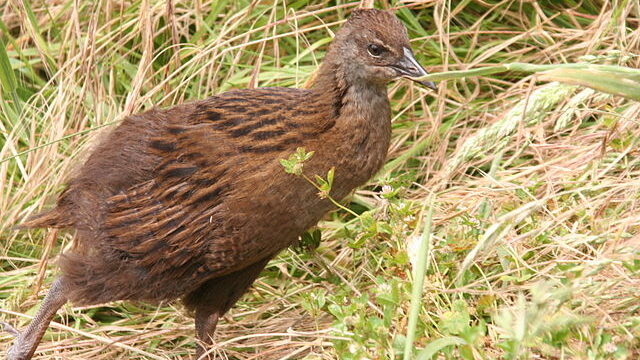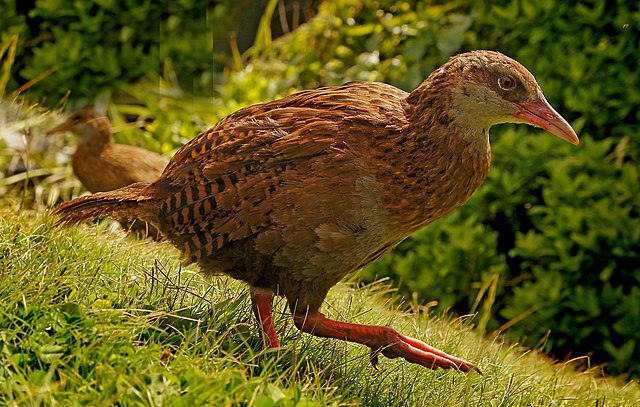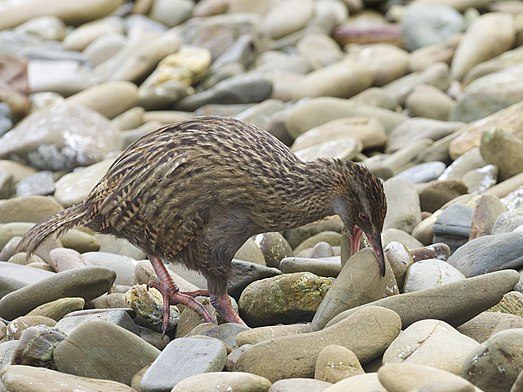Weka are omnivores with a curiosity for anything new, which makes them vulnerable to 1080 poison. They’re known to swallow the types of pellets used in 1080 operations and for that reason, learning more about the costs and benefits to weka has been a recent research priority.

Department of Conservation scientists Joris Tinnemans et al, recently published the results of their investigation into weka and 1080 in the New Zealand Journal of Ecology.
“The impact of aerially applied 1080 poison on a Western weka (Gallirallus australis australis) population was assessed at Tennyson Inlet, Marlborough Sounds, between September 2010 and June 2016. We estimated mortality and the incidence of sublethal poisoning as a direct consequence of two aerial 1080 operations and examined the differences in nest success, chick survivorship and adult survivorship.”
In the past, 1080 operations were aimed at reducing possum numbers and combatting TB but recent operations have targeted ship rats with the aim of reducing predation of native wildlife – particularly during beech masts when rodents can reach plague proportions due to the abundance of food. There is a benefit to wildlife in having less predators around, but does it outweigh the cost of individual native wildlife also being killed?

“Individuals of many native New Zealand bird species are known to have been killed during 1080 operations. Despite these deaths, the populations of several forest bird species have been shown to benefit from 1080 because of reduced predator abundances. The net effect of 1080 use, weighing non-target mortality against the effects of reduced predation, has not been adequately monitored for many native species, including weka (Gallirallus australis).”
As well as detecting whether any monitored weka died as a result of 1080 ingestion, the researchers also investigated sub-lethal effects from weka eating small amounts of the toxin.
“Most weka in the treated block appear to have been sublethally poisoned but only one of 58 (1.8%) radio-tagged weka died as a direct consequence of 1080 application.”
The sub-lethal amounts of 1080 did have a measurable effect on the birds however.
“There was a significant difference in the activity of our study birds after the 1080 operation in the treatment block compared with the non-treatment block. In the 3 days following the 1080 operation, the average daily activity of weka with diagnostic transmitters dropped by 31.2% ± 4.6% and 8.0% ± 4.3% in the treatment and non-treatment block respectively. All individuals in the treatment block had a pronounced drop in activity during the 3 days following the poison operation compared to 7 days immediately prior to the operation but seemed to revert to normal daily activity levels within approximately 7 days.”
Nest success was found to be unaffected by the reduction in rats and stoats following the 1080 operations.
“Statistical analysis of nest success data did not support the notion that 1080 affected nest success after either the 2013 or 2014 1080 operations. During this study, automatic cameras recorded a variety of mammals including mice, rats, possums, stoats and cats investigating weka nests, but none of these nests failed. The only observed predation was caused by another weka. Predation of weka nests by introduced mammals (perhaps excluding dogs) seems to be rare. Perhaps because weka are relatively large and aggressive birds they are able to protect their nests from most predators. Since weka nests are rarely preyed upon by mammalian predators there is little scope for an improvement in nest success following 1080 bait application.”
The study also investigated overall survivorship of both adults and chicks in the longer term.

“During the stoat irruption in 2015, chick survival was 12% in the untreated block and 80% in the treated block. Weka survivorship was improved by the 1080 application in 2014, but not in 2013. We speculate that the difference is related to stoat abundance as indexed by tracking rates. In 2013 there were relatively few stoats, weka survival was high and the poisoning of a few stoats by 1080 made little difference. In contrast, after the 2014 operations stoats were abundant and weka survival was low, except in our treatment block where the poisoning of stoats with 1080 caused a substantial decrease in stoat abundance and a substantial increase in weka survivorship.”
Overall, the researchers believe that 1080 has more benefits than costs for weka.
“Although we know that at least one weka was killed by 1080 in 2013, our statistical analysis did not support the notion that 1080 operations had an adverse effect on the long-term survivorship of weka. It seems that although weka can be killed by 1080, the low mortality is undetectable when measured on an annual timescale. Previous studies suggest that at national or regional scales, habitat loss and drought are major contributing factors to a reduction in weka populations. No habitat was lost during our study and the difference in weka survival between the treatment and non-treatment blocks excludes drought as an explanation for the decline we observed in our non-treatment block. In our study, stoat predation is the most likely explanation for the reduction in weka we observed.”
The benefits to weka depend on the timing of 1080 operations however, with benefits outweighing costs only when weka are under increased predation pressure from stoats.
“The net effect of aerial 1080 application on this weka population was positive when the operation followed a beech mast and stoat irruption, as adult and chick survivorship after the operation exceeded adult mortality during the operation. However, 1080 operations carried out when stoats are uncommon may have a minor negative impact on weka populations due to the risk of primary poisoning without compensatory increases in survivorship.”
The full research report is published in the New Zealand Journal of Ecology and is freely available online.

